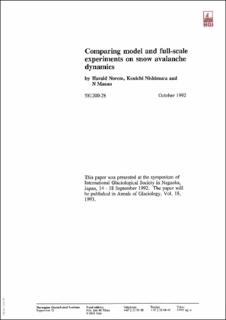| dc.contributor.author | Norem, Harald | |
| dc.date.accessioned | 2023-07-31T09:19:35Z | |
| dc.date.available | 2023-07-31T09:19:35Z | |
| dc.date.issued | 1992-10-01 | |
| dc.identifier.uri | https://hdl.handle.net/11250/3081916 | |
| dc.description.abstract | The paper is a part of a Japanese - Norwegian collaboration on snow avalanche
dynamics. The results of model experiments carried out at the Institute of Low
Temperature Science, Sapporo are compared with full-scale experiments and
theoretical models made by NGI.
Avalanching snow is modelled as the flow of granular materials having viscoplastic behaviour. The model experiments indicates that a slip velocity is only found
for smooth boundary conditions and there is a distinct velocity gradient at all
heights above the bed. The friction at the bed is caused by a Coulomb-friction
and a dynamic-friction part, of which the first seems to be most important.
The backcalculation of real avalanches also indicates that the Coulomb-friction
represents the major energy dissipation. The backcalculated values for the viscosities fits fairly well into existing theories and the results of the model experiments. | en_US |
| dc.description.sponsorship | K Nichimura | en_US |
| dc.language.iso | eng | en_US |
| dc.publisher | Norges Geotekniske Institutt | en_US |
| dc.relation.ispartofseries | NGI-rapport;58120-28 | |
| dc.rights | Navngivelse 4.0 Internasjonal | * |
| dc.rights.uri | http://creativecommons.org/licenses/by/4.0/deed.no | * |
| dc.subject | Avalanche-RnD | en_US |
| dc.subject | Snøskred-FoU | en_US |
| dc.subject | Snow Avalanche | en_US |
| dc.subject | Model | en_US |
| dc.subject | Granular Material | en_US |
| dc.subject | Velocity | en_US |
| dc.title | Comparing model and full-scale experiments on snow avalanche dynamics | en_US |
| dc.type | Research report | en_US |
| dc.source.pagenumber | 24 | en_US |
| dc.relation.project | The Ryggfonn project | en_US |

